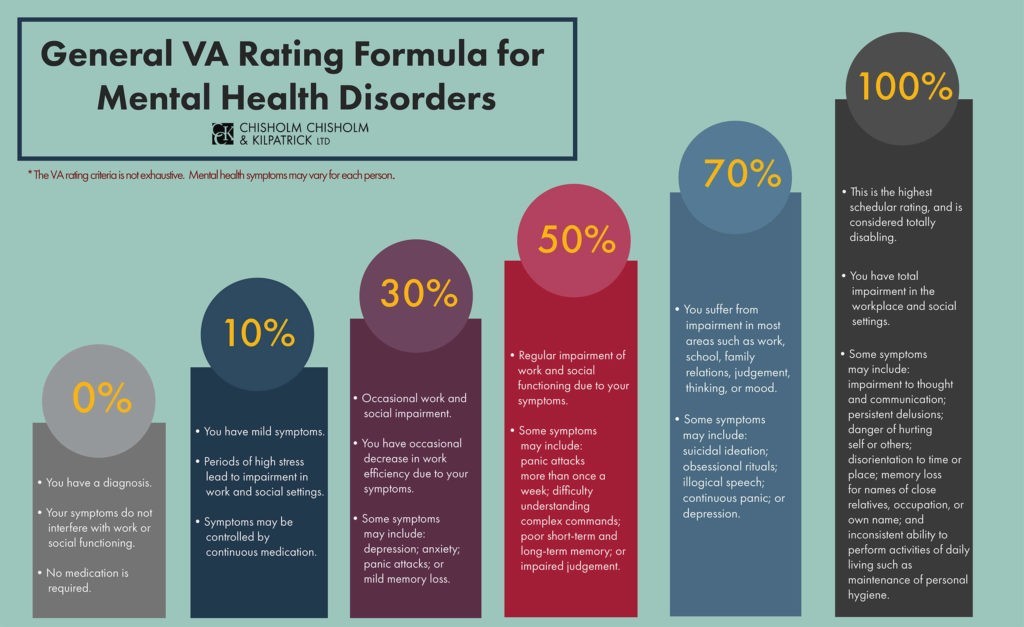VA Disability Ratings for Anxiety

CCK Law: Our Vital Role in Veterans Law
VA Disability Ratings for Anxiety
Anxiety is defined as intense, excessive, and persistent worry and fear about everyday situations. It is estimated that one-third of adults in the United States suffer from anxiety disorders. The most common symptoms of anxiety disorders include the following:
- Feeling restless, jumpy, or on edge,
- Excessive worrying,
- Difficulty concentrating,
- Rapid heartbeat,
- Trembling or twitching,
- Muscle tension,
- Shortness of breath or difficulty breathing,
- Feeling dizzy, nauseous, or lightheaded, and
- Difficulty sleeping.
There are several types of anxiety disorders, such as generalized anxiety disorder, panic disorder, and various phobia-related disorders. Veterans suffering from anxiety disorders may be eligible for VA disability benefits if they can demonstrate that their anxiety is due to their military service.
Service Connection for Anxiety Disorders
To establish direct service connection for an anxiety disorder, veterans must establish the following:
- A current diagnosis of an anxiety disorder;
- An in-service occurrence that caused or aggravated the anxiety disorder; and
- A medical nexus connecting the current, diagnosed anxiety disorder to the in-service occurrence
Examples of in-service occurrences might include if a veteran specifically treats for their anxiety during their time in service, or if they check off that they are experiencing anxiety-like symptoms at the time of their discharge examination.
It is important to note that the in-service occurrence element of service connection does not require that the veteran have an official diagnosis of an anxiety disorder during service. Instead, a veteran can be diagnosed with an anxiety disorder following service and still receive benefits, as long as they can establish their current condition is connected to service. A medical opinion is almost always required to establish this nexus.
Secondary Service Connection for Anxiety
Secondary service connection represents an alternative way to get service connection for anxiety. In this case, if veterans have an already service-connected condition that is either causing or aggravating their anxiety, then secondary service connection may be warranted.
For example, a veteran may have a service-connected knee condition that causes significant pain and impedes their ability to carry out everyday activities and tasks. As a result, the veteran may become very anxious about their functionality and ability to live a normal life.
Here, the veteran may be entitled to secondary service connection for their anxiety as a result of their service-connected knee condition. However, veterans must still establish a nexus showing that their already service-connected condition caused or aggravated their anxiety.
What if Veterans Were Diagnosed with Anxiety Before Service?
Even if a veteran received an initial diagnosis of an anxiety disorder before entering the military, they may still qualify for VA disability benefits. In this case, the veteran would need to prove that his or her military service aggravated, or worsened, the preexisting anxiety disorder beyond its natural progression.
This process is similar to proving service connection on a direct basis. Here, the difference is that VA classifies the worsening of a preexisting condition as a service connection based on aggravation.
Compensation & Pension (C&P) Exams for Anxiety
Compensation & Pension (C&P) exams are generally used to determine if there is a nexus between the veteran’s current, diagnosed condition and their time in service. Veterans will typically meet with a VA doctor and discuss their medical history, time in service, and current condition. The VA examiner will also ask about the veteran’s current symptomatology to determine the severity of their anxiety disorder. Veterans must always attend their C&P exams, or notify VA immediately if they cannot. Failure to attend a C&P exam will likely result in VA automatically denying benefits.
After attending a C&P exam, veterans should always request a copy of the results. Veterans are entitled to a copy of the exam; however, VA will only provide it if the veteran explicitly asks for a copy of it.
Once veterans have the C&P exam, they should go through it thoroughly and identify whether there are any problems or discrepancies. If so, they should follow up with VA to point those out, which can be done by submitting additional evidence or argument.
Evidence for Anxiety Claims
VA C&P exams represent one form of evidence for anxiety disorder claims. However, there are other types of evidence veterans can submit as well.
For example, lay evidence, including statements from veterans and their family and friends, can be very beneficial. Often, veterans do not seek treatment for their anxiety disorders right away due to the stigmatization that exists around mental health conditions. Lay statements can help fill in the gaps by describing both the onset and progression of the anxiety disorder. Veterans can also submit private treatment records from non-VA doctors or psychologists.
How Does VA Rate Anxiety Disorders?
When rating service-connected anxiety disorders, VA uses the General Rating Formula for Mental Disorders included in 38 CFR § 4.130 to assign one of the following percentages: 0, 10, 30, 50, 70, or 100. These ratings are based on the level of social and occupational impairment a veteran experiences, and the severity of symptoms VA uses to characterize that impairment.
All of the following anxiety disorders are categorized by a diagnostic code (DC) and rated based on this general formula:
- DC 9400: Generalized anxiety disorder
- DC 9403: All phobias, including social anxiety disorder
- DC 9404: Obsessive-compulsive disorder
- DC 9410: Other specified anxiety disorder
- DC 9411: Post-traumatic stress disorder
- DC 9412: Panic disorder and/or agoraphobia
This portion of the rating schedule is based on the American Psychiatric Association’s Diagnostic and Statistical Manual of Mental Disorders, Fifth Edition (DSM-5). According to 38 CFR § 4.125, Diagnosis of Mental Disorders, if the diagnosis of a mental disorder does not conform to DSM-5, the rating agency will return the VA examination report to the examiner to substantiate the diagnosis.
Additionally, if the diagnosis of a mental disorder is changed, the rating agency will determine whether the new diagnosis represents:
- Progression of the prior diagnosis,
- Correction of an error in the prior diagnosis, or
- Development of a new and separate condition.

Differences Between 50% and 70% Anxiety Ratings
The criteria for 50 percent and 70 percent anxiety disability ratings are very similar in terms of the language that is used when referencing occupational and social impairment:
- “50% – occupational and social impairment with reduced reliability and productivity…”
- “70% – occupational and social impairment, with deficiencies in most areas…”
VA has not yet provided exact definitions for the abovementioned phrases. However, the diagnostic codes provide examples of the types of symptoms that may fall under each. For example, in the 50 percent criteria, “reduced reliability and productivity” may include impaired judgment, impaired abstract thinking, panic attacks more than once per week, flattened affect, etc.
For the 70 percent rating criteria, “deficiencies in most areas” involve more aspects of life and may include suicidal ideation, obsessive rituals, and an inability to establish and maintain effective relationships.
In denying a higher disability rating for anxiety, VA must explain to veterans why they are not entitled to the higher rating by providing adequate reasons and bases. If VA fails to do so, then veterans have the right to appeal.
Pyramiding and Anxiety Claims
When a mental health condition, such as an anxiety disorder, overlaps with a non-psychiatric condition, VA will avoid “pyramiding.” This means that VA will only compensate a symptom that a veteran is experiencing once.
If a veteran suffers from an orthopedic condition that causes sleep impairment and a psychiatric condition that also causes sleep impairment, VA will rate that symptom under one of those conditions and not the other. In other words, VA will not compensate a veteran for the same symptom twice.
Do Veterans Have to File Separate Claims for Multiple Mental Health Conditions?
Since mental health conditions share similar symptomatology, VA will consider the combined effects of the conditions to determine the overall level of social and occupational impairment. Although veterans may have another diagnosed mental health condition in addition to their anxiety disorder, VA will only assign one disability rating.
When veterans submit a claim for a particular mental health condition, VA will process their claim as a claim for any mental health condition. Therefore, VA does not limit its consideration to the particular mental health condition that was identified in the veteran’s claim.
For example, if a veteran’s initial claim is for PTSD, but the evidence of record reflects that they are also diagnosed with depression, VA is required to consider the veteran’s depression in connection with the initial claim for PTSD. As such, the assigned rating will reflect the severity and impact of both.
Appealing Anxiety Disorder Claims Under Appeals Modernization Act (AMA)
Under the Appeals Modernization Act (AMA), veterans have multiple options to choose from when appealing an unfavorable decision from VA, including the higher-level review lane, supplemental claim lane, and Notice of Disagreement (i.e. appeal to the Board of Veterans’ Appeals) lane.
If veterans are choosing the supplemental claim lane, they must make sure that they are including new and relevant evidence with their claim. “New and relevant” is supposed to be a lower evidentiary standard and can include lay statements, medical evidence, etc. However, it must be something that is relevant to the veteran’s claim that VA has not considered previously.
Overall, AMA is supposed to provide veterans with more choices within the appeals process. Nonetheless, there are still aspects of AMA that remain unclear. As such, veterans are encouraged to consult with Veterans Service Organizations or attorneys when initiating appeals under this new system.
Hospitalization for Anxiety Disorders
According to VA, periods of hospitalization are considered to be totally disabling. In situations where veterans are hospitalized due to their service-connected anxiety disorders for more than 21 days, they should be entitled to a 100 percent disability rating for the period of their hospitalization.
If veterans are hospitalized for an extended stay of more than six months, they are not only assigned the 100 percent total rating for the entire length of the hospitalization, but also an additional six months after the date of discharge. Veterans must tell VA immediately if they are hospitalized to ensure they are compensated properly.
TDIU for Anxiety Disorders
Total disability based on individual unemployability (TDIU) is another avenue to receiving a 100 percent disability rating. If a veteran’s service-connected anxiety disorder alone, or service-connected anxiety disorder in combination with other service-connected conditions, prevents them from securing and maintaining substantially gainful employment, then they may be entitled to TDIU benefits. Here, substantially gainful employment typically refers to an annual income that meets or exceeds the federal poverty threshold.
About the Author
Share this Post

